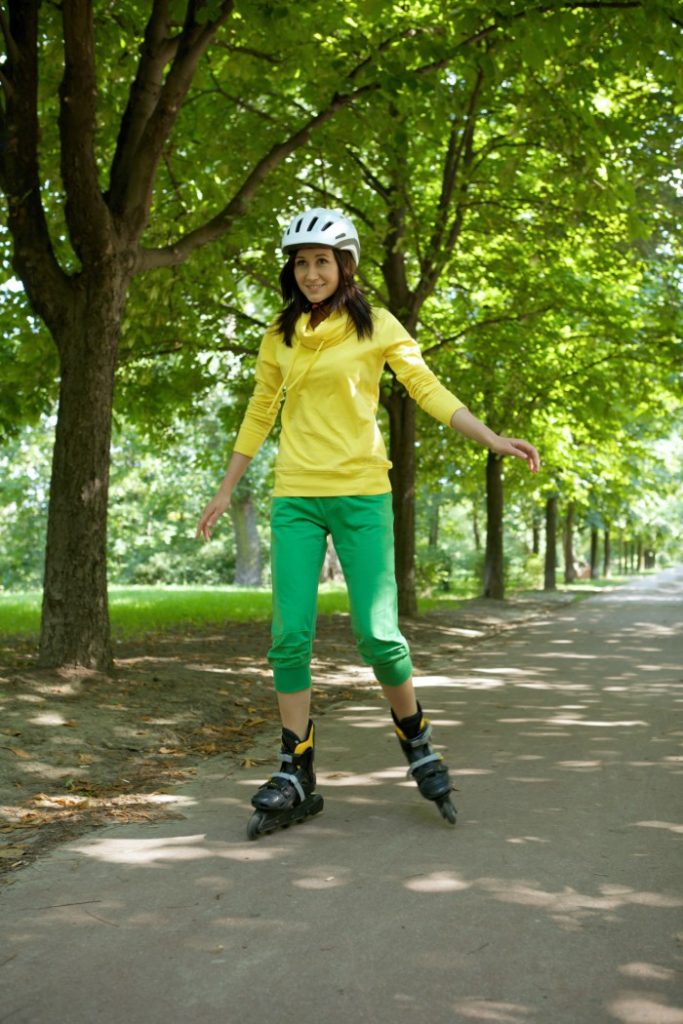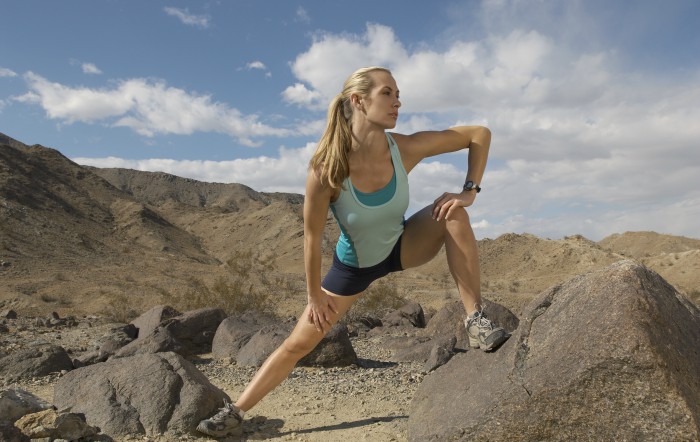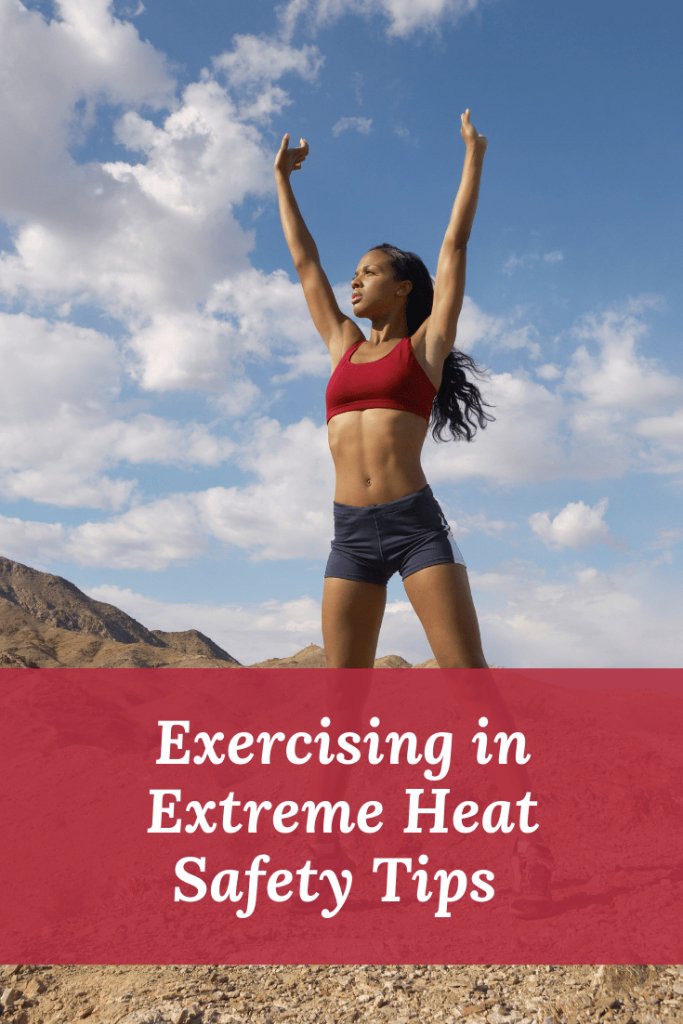Are you exercising in extreme heat? Exercising outside during the summer months can be brutal if it is extremely hot outside where you live. But that doesn’t mean you should give up on your exercise routine due when it is too hot outside. Safety during the summer months can prevent heat-related injuries or illnesses.
Disclosure: This post contains affiliate links.
When it is extremely hot outside, you need to use extreme caution and use common sense before starting your exercise routine outdoors. After living in Texas and surviving the extreme heat for several decades, trying to exercise outdoors during the summer months can be challenging but not impossible.
Exercising in extreme heat puts additional stress on your body especially if your body isn’t acclimated to the heat. As temperatures begin to soar, it is wise to change up your exercise routine and make adjustments so that you don’t have to exercise outdoors during the hottest part of the day. Let’s take a look at some important safety tips to follow if you are unable to modify or move your exercise routine when it is extremely hot outside
Drink Plenty of Water
During the summer months, it is important to increase your water intake if you plan on exercising outdoors when it is extremely hot. Dehydration and extreme heat can cause major health problems. Prevention is one of the best ways to avoid becoming dehydrated even if you don’t plan on exercising outside in the extreme heat.

Being dehydrated can make you feel exhausted or ill. But as your body begins to heat up in extreme temperatures, your body attempts to cool itself by producing sweat. When your body can’t produce enough sweat to cool your body off, you increase your risk of overheating. Extreme overheating can lead to heat-related illnesses, even death.
If you do end up exercising outside when it is extremely hot, do make sure that you stop and take plenty of water breaks to help replenish the water you are losing. You should avoid waiting until you are thirsty to begin replacing lost fluids. According to Contra Costa Health Services, when exercising in extreme heat, you should be drinking two to four glasses (16-32 ounces) of cool fluids each hour to replace lost fluids and to help cool your body off.
Also, make sure that you properly re-hydrate after you finish working out in extreme heat. When it is hot outside, you tend to lose more sweat and it is important to replace those lost fluids.
Load Up on Carbs Prior to Exercising in Extreme Heat
Your body needs additional carbohydrates when you exercising in extreme heat conditions. Carb loading gives your body additional energy during to get through an intense workout in the heat. Most people think that eating too many carbs is unhealthy. However, when it is hot outside we suggest avoiding carbs that are loaded with dry ingredients. When you eat dry ingredients, your body uses more water to process it.
Instead, try eating a small snack about 30 minutes before exercising in extreme heat. Opt for eating fast acting carbs that aren’t going to leave you feeling sluggish. Fresh fruit, smoothies, oatmeal topped with fresh fruit, greek yogurt with fruit, brown rice, sweet potatoes, vegetables with chicken and rice, or protein shakes are excellent sources of fast-acting carbs that won’t weigh you down.
You can add refined carbs if you plan on eating them several hours before working out. Pasta, bagels, whole grains, and potatoes are excellent for carb loading before working out in extreme heat.

Wear the Right Clothing
Anytime you are outside in the heat, you should always opt to wear light-colored clothing that is breathable. We love the moisture wicking athletic wear the best because it is designed to help keep you cool. Wearing dark-colored clothing attracts heat and increases your chances of overheating.
Monitor Weather Alerts
During the summer months, the National Weather Service issues heat warnings to warn when outdoor temperatures reach a dangerous point. Always pick a safer time to workout or head indoors for today’s workout if there is an active alert in your area. There is no need to pass out or get sick when you can pick an alternative way to work out when it is extremely hot outside. Heat-related illnesses are more likely to occur when the National Weather Service issues a heat advisory or warning in your area.
Don’t forget to check for the Weather Channel app or websites for active Ozone advisory or alerts too. Being in the DFW metroplex we frequently receive ozone advisories or alerts when the ozone levels become increasingly dangers. All ozone levels are monitored and predicted by the (Environment Protection Agency (EPA).
When ozone reaches dangerous levels, the outdoor air to be deemed unsafe for certain ailments. It is known to cause respiratory distress when you breathe in ozone toxins for long periods of time. Also, it affects people who are diagnosed with breathing difficulties such as asthma, COPD, or other ailments.
Acclimate Your Body to the Extreme Heat
If you aren’t used to exercising in extreme heat, it is important that you take the time to slowly acclimate your body before you perform any intense cardio workout or hard workout such as football, soccer, running, speed walking, etc. It is easy to overdo when you aren’t used to exercising outdoors in the heat. Overdoing increases your risk of heat-related illnesses. Instead, focus on building your intensity and the duration of your workouts slowly to avoid potential problems when exercising in extreme heat.
Acclimating your body to the extreme heat can drastically reduce your chances of dealing with complications from heat-related illnesses. It also increases your body performance to withstand extreme heat. You will need to take it slowly for 10 to 14 days in order for your body to fully acclimate unless you have been working out as temperatures slowly climb. Remember if you have skipped a few workouts outdoors during the summertime, it is important to re-acclimate your body to the extreme heat before returning to your normal outdoor workout routine.

Always Listen to Your Body
Heat-related illnesses should be taken seriously. Ignoring symptoms could lead to a stroke or even death. Stop exercising immediately if you start feeling dizzy, lightheaded, cold and clammy skin, confusion, muscle cramps, stomach cramps, nausea, or vomiting. Find a cool spot and sit down until your body starts to cool off if possible find a location indoors. As long as you aren’t vomiting, slowly sip on water or sports drink to help replenish lost electrolytes.
Move Your Workout
Working out in the extreme heat causes additional stress on your body. So if possible, try and find a shaded trail or even take your workout indoors, at the gym or use a home gym, when it is extremely hot outside.
Staying out of the direct sunlight is best so that it feels a bit cooler while working out. Your health is your number one priority and moving your workout is for your safety.
Avoid Intense Workouts When it is Extremely Hot Outside
As temperatures begin to rise, you should remember that now isn’t the time to overexert yourself and switch to less intense workout options. It is always better to decrease your pace and take extra rest breaks. Don’t be discouraged by slowing down your workout pace. It isn’t the end of the world and it is much better to play on the safe side. Instead, focus on completing your workout without compromising your health.
Adjust your Workout Schedule
We recommend that you adjust your workout schedule so that you avoid working out in the extreme heat. Whether you choose to get up early and knock out your workout before you start your day or choose to exercise after the sun goes down in the late evening.
It is better to work out in the early mornings when temperatures are at their lowest point and avoid working out during the day when temperatures spike. If you aren’t a morning person, it is better to workout late evening after the sun sets. Skip working out any other time unless you are prepared to move your workout indoors or find alternative summer workouts to use when it is extremely hot outside.
Use a Wet Cooling Towel
We suggest that you purchase and use a wet cooling towel when you are exercising in extreme heat. A wet cooling towel can be used to wipe the sweat off your brow or it can be wrapped around your neck to help keep you cool. Cooling towels use evaporative cooling once you add cool water and wave it in the air. Unlike, regular towels the cooling towel stays cool. It uses the moisture from your sweat and water to keep it cool.
Exercising outdoors in extreme heat can be brutal. But that doesn’t mean that you have to give up your entire summer workout routine. Safety should be your number one priority if you plan on exercising in extreme heat. Following our safety tips above can help reduce your chances of being a victim of heat-related illnesses including stroke or even death.


